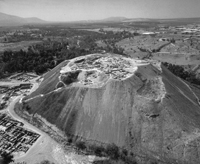 The site of Beth Shean (modern Beisan) is 17 miles (27 km) south of the Sea of Galilee, at the strategic junction of the Harod and Jordan Valleys, and the site was almost continuously occupied from the Chalcolithic period to the present. Between 1921 and 1933, excavations conducted under the auspices of the University Museum uncovered eighteen city levels dating from the late Neolithic period (4500 B.C.E.) through the 12th century C.E. At the time of the conquest, according to the Bible, Beth Shean was one of the cities from which the Israelites did not rout the Canaanites (Joshua 17:11; Judges 1.27). It was also named as the city onto whose walls the Philistines "fastened" the body of Saul and those of his sons (I Samuel 31:10). The project at Beth Shean was one of the largest excavations of its time. Among the most impressive finds were those from the late Bronze to early Iron Age (1400 to 1150 B.C.E.) when it was an Egyptian administrative center and garrison. The highlight of the excavations was the discovery of a series of five Canaanite and hybrid Egypto-Canaanite temples. Burials contemporary with these city levels were excavated in the north cemetery.
The site of Beth Shean (modern Beisan) is 17 miles (27 km) south of the Sea of Galilee, at the strategic junction of the Harod and Jordan Valleys, and the site was almost continuously occupied from the Chalcolithic period to the present. Between 1921 and 1933, excavations conducted under the auspices of the University Museum uncovered eighteen city levels dating from the late Neolithic period (4500 B.C.E.) through the 12th century C.E. At the time of the conquest, according to the Bible, Beth Shean was one of the cities from which the Israelites did not rout the Canaanites (Joshua 17:11; Judges 1.27). It was also named as the city onto whose walls the Philistines "fastened" the body of Saul and those of his sons (I Samuel 31:10). The project at Beth Shean was one of the largest excavations of its time. Among the most impressive finds were those from the late Bronze to early Iron Age (1400 to 1150 B.C.E.) when it was an Egyptian administrative center and garrison. The highlight of the excavations was the discovery of a series of five Canaanite and hybrid Egypto-Canaanite temples. Burials contemporary with these city levels were excavated in the north cemetery.
© 2025 The Trustees of the University of Pennsylvania
